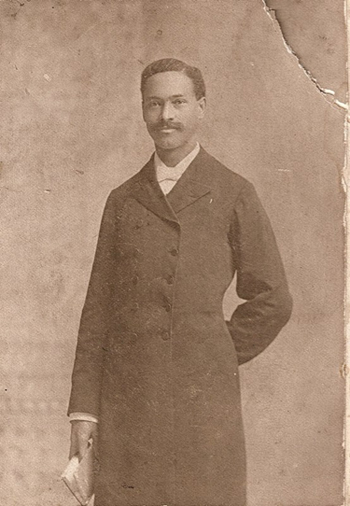Oberlin Has Tie to “12 Years a Slave” Character
Wednesday, January 8th, 2014By David Fiske, Co-author of Solomon Northup: The Complete Story of the Author of Twelve Years a Slave, Praeger, 2013.
Though Louisiana is the primary setting for the film 12 Years a Slave, there is a connection between Oberlin and one of the characters featured in the movie. Harriet Shaw, admirably played by Alfre Woodard, was a real person, whose son Daniel Webster Shaw lived in Oberlin for several years, and is buried in Westwood Cemetery.
The role of Harriet Shaw is perhaps a source of confusion for some viewers of the movie. Why is a black woman, a former slave, living an easy life of comfort in the midst of a region full of plantations where other slaves were being worked nearly to death?
The film is based on the 1853 book, Twelve Years a Slave, by Solomon Northup (played by Chiwetel Ejiofor). Northup’s book did not say a lot about Harriet Shaw (in fact, in one place he mistakenly gives her first name as Charlotte), but he does say that she had been a slave to Mr. Shaw, who had taken her as his wife, and that there were several children in their household. Northup wrote that Harriet extended many kindnesses to poor Patsey (played by Lupita Nyong’o), being aware of Patsey’s difficult situation.
Though not typical, it was not entirely unusual for a slave owner to enter into a domestic relationship with a slave. Northup tells that, earlier in life fellow slave Eliza (Adepero Oduye) had lived with her master, who had broken off relations with his wife. Northup writes that Eliza had “resided with him…nine years, with servants to attend upon her, and provided with every comfort and luxury of life.”
Even the notorious Theophilus Freeman (Paul Giamatti), the slave trader who sold Northup at New Orleans, lived with a mulatto woman named Sarah Conner, who had been his slave but whom he had allowed to purchase her freedom.
Harriet Shaw existed in real life. The 1860 census shows that a 25-year-old black woman by that name lived in the household of a P. L. Shaw (his first name was probably Pleasant)–and not as a slave. The census listing shows a number of children in the household, their races given as “mulatto.” Some appear to be too old to have been the children of Harriet, but the younger ones certainly could have been.
One of the children, Daniel, was born about 1858. It seems very likely that this son of Harriet, whose full name was Daniel Webster Shaw, is the same man who, after obtaining a very impressive college education, was a prominent clergyman and writer. According to his death certificate and a record of the 1942 death, in Oberlin, of his son, Carl Clifford Shaw, Rev. Shaw was born in Eola, Louisiana. Eola is a village located on Bayou Boeuf, and the location of the plantation of Edwin Epps (Michael Fassbender), to whom Northup and Patsey belonged. Though other records show that Daniel was born in 1859 or 1860, these dates are reasonably consistent with the information in the 1860 census listing. Eola is very small, and it seems unlikely that two different men named Daniel Shaw would have been born there around the same time.
Rev. Daniel Webster Shaw
(Source: David James submission on Find a Grave)
Daniel Shaw attended a school not far from the plantation where his mother had lived (and where Patsey had visited her frequently). In a message sent by Rev. Shaw to a woman named Rosetta Ann Colt (who had gone to Louisiana after the Civil War to start schools for blacks), he recalled “I think of school days on the Tache [ “Teche,” for Bayou Teche, where Miss Colt had run a school] and all the kind ways in which you helped me to start out in life. If I could be permitted, how gladly would I again fill up the wood-box in your room and kindle the fire on your hearth,” and he credits his success to her help and advice. At the time he wrote this, he was the pastor of a church in Pittsburgh, Pennsylvania.
Shaw continued his education at Baldwin University in Berea, Ohio (today known as Baldwin Wallace University), graduating in 1883–the first black person to do so. He also pursued studies at Boston University, Oberlin College, and later on, at Wiley University, where he was granted a Doctor of Divinity degree in 1900. As a minister he served congregations in Baltimore, Maryland; Pittsburgh, Pennsylvania; Charleston, West Virginia; Cleveland, Ohio, and in Oberlin, where he served the Rust Methodist Episcopal Church in the 1880s and 1890s. Rev. Shaw married Alice L. Bookram in Oberlin on January 23, 1888, and in 1896 the family resided at the Readie Brooks House at 60 North Park Street.
In addition to his pastoral duties, he at one point was on the faculty at Howard University, and authored many articles and pamphlets. Suffering ill health, the Rev. Dr. Shaw was forced to leave the ministry, and he returned to Oberlin in the summer of 1914, residing at 309 North Main Street. He passed away on September 28, 1914.
AUTHOR BIO:
David Fiske is a retired librarian who is a freelance writer and researcher in upstate New York. His interest in Solomon Northup began in the 1990s, and his research is included in a 2013 book he co-authored titled Solomon Northup: The Complete Story of the Author of Twelve Years a Slave.
SOURCES CONSULTED:
Marriage and death certificates referenced are available on familysearch.org.
Ohio Historic Inventory LOR-02073-21, Readie Brooks House, Ohio Historic Preservation Office. Contains some references to Rev. Shaw’s residence in Oberlin.
Daniel W. Shaw, The Second Emancipation of the Negro: An Address to the Colored Voters of West Virginia, 1900 [no publisher given]. Includes a biographical note about Shaw.
“African Missions,” Northern Christian Advocate [Syracuse, New York], October 26, 1905. Biographical sketch of Rosetta Ann Colt includes a quote from a letter sent to her by Rev. Shaw.
Solomon Northup, Twelve Years a Slave. Originally published in 1853; many editions now available.







